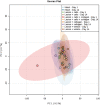Proteomic profiling of striatal tissue of a rat model of Parkinson's disease after implantation of collagen-encapsulated human umbilical cord mesenchymal stem cells
- PMID: 32548924
- PMCID: PMC7496133
- DOI: 10.1002/term.3081
Proteomic profiling of striatal tissue of a rat model of Parkinson's disease after implantation of collagen-encapsulated human umbilical cord mesenchymal stem cells
Abstract
Parkinson's disease (PD) is the most common neurodegenerative disorder of movement worldwide. To date, only symptomatic treatments are available. Implantation of collagen-encapsulated human umbilical cord mesenchymal stem cells (hUC-MSCs) is being developed as a novel therapeutic approach to potentially modify PD progression. However, implanted collagen scaffolds may induce a host tissue response. To gain insight into such response, hUC-MSCs were encapsulated into collagen hydrogels and implanted into the striatum of hemi-Parkinsonian male Sprague-Dawley rats. One or 14 days after implantation, the area of interest was dissected using a cryostat. Total protein extracts were subjected to tryptic digestion and subsequent LC-MS/MS analyses for protein expression profiling. Univariate and multivariate analyses were performed to identify differentially expressed protein profiles with subsequent gene ontology and pathway analysis for biological interpretation of the data; 2,219 proteins were identified by MaxQuant at 1% false discovery rate. A high correlation of label-free quantification (LFQ) protein values between biological replicates (r = .95) was observed. No significant differences were observed between brains treated with encapsulated hUC-MSCs compared to appropriate controls. Proteomic data were highly robust and reproducible, indicating the suitability of this approach to map differential protein expression caused by the implants. The lack of differences between conditions suggests that the effects of implantation may be minimal. Alternatively, effects may only have been focal and/or could have been masked by nonrelevant high-abundant proteins. For follow-up assessment of local changes, a more accurate dissection technique, such as laser micro dissection, and analysis method are recommended.
Keywords: Parkinson's disease; collagen hydrogels; mesenchymal stem cells; proteomics; rat model; regenerative medicine.
© 2020 The Authors. Journal of Tissue Engineering and Regenerative Medicine published by John Wiley & Sons Ltd.
Conflict of interest statement
The authors have declared that there is no conflict of interest.
Figures






Similar articles
-
Heat shock protein 60 affects behavioral improvement in a rat model of Parkinson's disease grafted with human umbilical cord mesenchymal stem cell-derived dopaminergic-like neurons.Neurochem Res. 2016 Jun;41(6):1238-49. doi: 10.1007/s11064-015-1816-6. Epub 2016 Jan 12. Neurochem Res. 2016. PMID: 26758268
-
Therapeutic potentials of human microfluidic encapsulated conjunctival mesenchymal stem cells on the rat model of Parkinson's disease.Exp Mol Pathol. 2021 Dec;123:104703. doi: 10.1016/j.yexmp.2021.104703. Epub 2021 Oct 5. Exp Mol Pathol. 2021. PMID: 34619140
-
Repair of lumbar vertebral bone defects by bone particles combined with hUC-MSCs in weaned rabbit.Regen Med. 2019 Oct;14(10):915-923. doi: 10.2217/rme-2018-0134. Epub 2019 Sep 26. Regen Med. 2019. PMID: 31556342
-
Insights into the Effects of Mesenchymal Stem Cell-Derived Secretome in Parkinson's Disease.Int J Mol Sci. 2020 Jul 23;21(15):5241. doi: 10.3390/ijms21155241. Int J Mol Sci. 2020. PMID: 32718092 Free PMC article. Review.
-
Mesenchymal Stem Cells-derived Exosomes: A New Possible Therapeutic Strategy for Parkinson's Disease?Cells. 2019 Feb 2;8(2):118. doi: 10.3390/cells8020118. Cells. 2019. PMID: 30717429 Free PMC article. Review.
Cited by
-
Neurorepair and Regeneration of the Brain: A Decade of Bioscaffolds and Engineered Microtissue.Front Cell Dev Biol. 2021 Apr 7;9:649891. doi: 10.3389/fcell.2021.649891. eCollection 2021. Front Cell Dev Biol. 2021. PMID: 33898443 Free PMC article. Review.
References
-
- Campos‐Martorell, M. , Salvador, N. , Monge, M. , Canals, F. , Garcia‐Bonilla, L. , Hernandez‐Guillamon, M. , … Montaner, J. (2014). Brain proteomics identifies potential simvastatin targets in acute phase of stroke in a rat embolic model. Journal of Neurochemistry, 130(2), 301–312. 10.1111/jnc.12719 - DOI - PubMed
Publication types
MeSH terms
Substances
LinkOut - more resources
Full Text Sources
Medical

